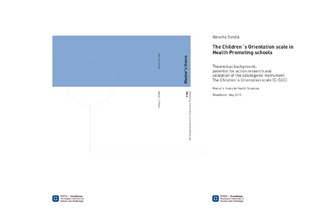| dc.description.abstract | This Master´s thesis consists of three articles. Article I is the base for Article II and III. The main aim of Article I is to clarify the theoretical framework of Antonovsky´s salutogenic concept, and to introduce a method for implementation of the scale as a tool for health promotion in school settings. The first part of Article I present the salutogenic model consisting of the health ease/ dis-ease continuum, general resistance resources and the concept sense of coherence. The original measure of the sense of coherence, The Orientation to Life scale is presented in it´s functionality, validity and reliability. The adaption to children, The Children´s Orientation scale (C-SOC) and the development of sense of coherence in children is presented as a background on how to implement this in school settings (Article II), including the Norwegian validation of the scale (Article III). Theories and concepts from the overarching model “the salutogenic umbrella” are used in the description of the development of sense of coherence in childhood. The second part of Article I introduces the action research spirals, the evidence on salutogenesis and action research, including a strategy for a resource oriented discourse. Article II discusses the possible advantages of using The C-SOC scale as guidance for health promotion activities among children in school nursing services. The first part of Article II introduces the importance of a community focus on children´s health, and the importance of a child - school nurse - family - teacher relationship in health promotion among school children. The salutogenic concept is mentioned as a framework with the potential of creating coherence in and between people and sectors in the construction of an overall “health promoting society”. The second part of Article II focus on a discussion of a health promoting strategy through school nursing services, with suggestion of the C-SOC scale as a preparatory questionnaire for health promoting dialogues. The discussion is based on the core elements of action research. Article III presents a study of the C-SOC scale in a Norwegian sample. The C-SOC scale was translated into Norwegian, and tested in a sample consisting of 157 children aged 8-10 from elementary schools in Trondheim. Exploratory principal component analyses and confirmatory factor analyses were used to test the factor structure of the scale, purposely to find if the one-factor structure Antonovsky suggested was confirmed. Reliability analysis was conducted with Cronbach´s alpha. Additional analysis, t-Test and One-way ANOVA, were used to test differences in age and gender. A higher order three-dimension factor structure gave the best fit for a model. On the basis of the results from the study it was indicated a need for improvement of the scale. | nb_NO |
